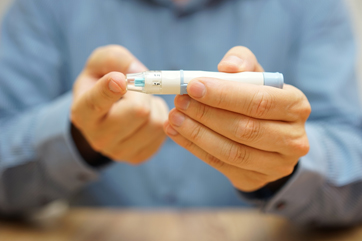Single blood sample accurately diagnoses diabetes
A single blood sample indicating elevated fasting glucose and HbA1c levels is strongly predictive of a diabetes diagnosis, according to a study published in Annals of Internal Medicine.
“Current clinical definitions of diabetes require repeated blood work to confirm elevated levels of glucose or HbA1c to reduce the possibility of a false-positive diagnosis,” Elizabeth Selvin, PhD, MPH, from Johns Hopkins Bloomberg School of Public Health, and colleagues wrote. “Whether two different tests from a single blood sample provide adequate confirmation is uncertain.”
Selvin and colleagues conducted a study to investigate the diagnostic performance of a single blood sample for unconfirmed diabetes. The researchers enrolled 12,268 patients without diagnosed diabetes. Participants were followed for incident diabetes, cardiovascular outcomes, kidney disease and mortality over 25 years.
The researchers defined high levels of fasting glucose (7 mmol/L) and HbA1c (6.5%) from a single blood sample as confirmed undiagnosed diabetes. Unconfirmed undiagnosed diabetes was defined as having only one elevated measure.

At baseline, elevated levels of fasting glucose or HbA1c were documented in 978 participants. Confirmed undiagnosed diabetes was seen in 39% of these participants, whereas unconfirmed undiagnosed diabetes was seen in 61%.
During follow-up, the confirmatory definition of undiagnosed diabetes had moderate sensitivity (54.9% at 5 years) and high specificity for identifying diagnosed diabetes cases (98.1% at 5 years and 99.6% at 15 years). After 15 years, the positive predictive value of the single sample was 88.7% for confirmed undiagnosed diabetes and 71.1% for unconfirmed.
Participants with confirmed undiagnosed diabetes were significantly likely to experience CVD, kidney disease, peripheral artery disease and mortality.
“Our findings support clinical use of a combination of HbA1c and fasting glucose levels from a single blood sample to identify cases of undiagnosed diabetes in the population, although these results will need to be confirmed in other data sets,” Selvin and colleagues concluded.
They noted that the new diagnostic method would eliminate the need for a second blood test.
In an accompanying editorial, K.M. Venkat Narayan, MD, MSc, MBA, and Ram Jagannathan, PhD, both from Emory University, noted that detecting diabetes early and simplifying approaches to do so is imperative to prevent or delay complications. The findings by Selvin and colleagues offer a promising new way to improve the timing and efficiency of diabetes diagnosis, they wrote.
“Selvin and colleagues offer an innovative and practical use of a single blood sample at one visit, rather than two samples obtained at two visits, to confirm the diagnosis of diabetes,” they wrote. “This approach has appeal, especially for resource-challenged settings, but it needs replication in other populations before becoming accepted clinical practice.” – by Alaina Tedesco
Disclosure: Jagannathan, Selvin and Venkat Narayan report no relevant financial disclosures. Please see study for all other authors’ relevant financial disclosures.

